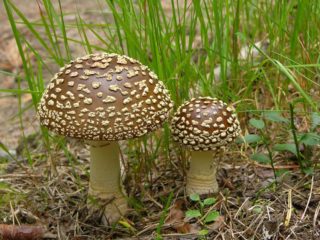Content
The bright yellow fly agaric is a poisonous specimen from the Amanita family, but in some countries it is eaten. It has a hallucinogenic effect, so it is better to avoid collecting bright yellow fly agaric.
Description of the bright yellow fly agaric
The yellow fly agaric (pictured) is characterized by inconsistency of color. Its cap can be pale straw, bright yellow or even orange. Therefore, identification of the fruiting body is difficult.
Description of the cap
The surface is smooth and dry. The diameter of the cap can be from 4 to 10 cm. Young specimens have a convex cap, which straightens with age. The edges of the cap are furrowed.
The plates under the cap are soft and often located. Young specimens are white, but with age they can turn yellow, acquiring a light ocher hue.
The flesh of the mushroom is white, but can be slightly yellow. The smell vaguely resembles the aroma of radish.
The spores are broadly ellipsoidal and the powder is white.
The remains of the coverlets on the cap are presented in the form of white flake-like plates.
Description of the leg
The leg of the bright yellow fly agaric is fragile, slightly elongated - 6-10 cm, white or slightly yellowish. The diameter of the leg is 0.5-1.5 cm; young specimens have a ring that disappears with age, leaving a barely visible mark. The surface is smooth, in some specimens there is slight pubescence.
Volva is poorly distinguishable, presented in the form of narrow rings on the swelling of the leg.
Where and how does the yellow fly agaric grow?
The bright yellow fly agaric forms mycorrhiza with coniferous trees, but is found in mixed and deciduous forests with linden, beech, oak, hazel, and hornbeam. Prefers sandy soils. The main growing area is the temperate zone of the European part and Eastern Siberia, but the mushroom is found occasionally.
The main fruiting period occurs in the warm season: from June to October.
Edible bright yellow fly agaric or poisonous
Consumption of this type of mushroom can lead to poisoning.
The effects of hallucinogens on the body
The pulp of the fly agaric contains toxic substances that have a poisonous effect on the human body:
- ibotenic acid acts on glutamine-sensitive receptors in the brain, enhancing motor activity; an overdose can lead to convulsions;
- muscimol leads to blocking of brain receptors, which causes depression of emotional activity.
The composition also includes other toxins (tryptophan, muscaridine, muscarine, hydrocarbolinecarboxylic acid), which have a minor effect on humans and cause a hallucinogenic effect.
Symptoms of poisoning, first aid
The symptoms are similar to those of poisoning that occurs after eating the panther fly agaric:
- thirst;
- severe dehydration;
- nausea;
- vomit;
- cramping pain in the stomach;
- increased lacrimation, drooling, sweating;
- dyspnea;
- dilation or constriction of the pupils, lack of reaction to light;
- fast or slow heartbeat;
- dizziness;
- attacks of fear;
- disturbance of consciousness, delirium;
- hallucinations;
- convulsions.
If the intoxication is minor, improvement is observed after a few hours. A severe form of poisoning is manifested by convulsions, coma and death. Death can occur within 6-48 hours.
First aid
- Call a medical team.
- Before their arrival, perform gastric lavage. Give the victim 5-6 glasses of warm water or a weak solution of potassium permanganate, after which a gag reflex occurs. Repeat the procedure several times. Collect the remaining mushrooms for laboratory testing.
- If there is no diarrhea in the first hours after taking mushrooms, you can use a laxative.
- If possible, do a cleansing enema.
- If there is a chill, the person is covered and warm heating pads are applied to the extremities.
- If the victim is vomiting, he is given a weak salt solution to drink in small sips. For a glass of water you will need 1 tsp. salt.
- If the victim complains of severe weakness, you can give strong tea with sugar or honey. You are allowed to drink milk or kefir.
Doubles and their differences
Yellow fly agaric can be confused with the following mushrooms:
- float yellow-brown It is distinguished by its smaller size, it does not have remnants of the cover on the cap, the leg is smooth, without thickening. Considered fit for consumption;
- fly agaric - inedible species. The color of the cap is lemon yellow, or may be greenish-gray. The plates are pale lemon-yellow, yellowish at the edges.
Conclusion
The bright yellow fly agaric is a hallucinogenic mushroom from the Amanitaceae family. When ingested in small quantities, it causes hallucinations and confusion; consumption of large doses leads to cardiac arrest and death.













